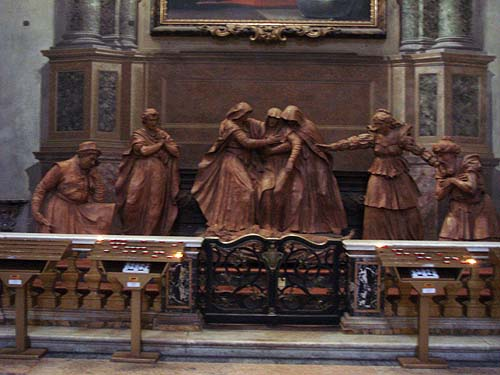
Leave Siena, arrive in Bologna
We got up, ate breakfast, cleaned up, finished packing, and made the train, first to Florence, then changing trains there for Bologna (we got to go first class from Florence to Bologna, which was nice, as there is a basic drink and snack service).
By the time we hit Bologna, we were already a bit burned out; one of our running jokes now is, “Let’s have Italian for dinner!” We’re staying at the Sheraton near the airport, so we checked our bags at the train station and walked into the city center, grabbing a sandwich for lunch; we stopped at the medieval museum but they weren’t open after 3P on Thursdays. Aviva did get some shots of a hotel and restaurant that have frescoed grotesques.
We walked further and stopped at Cattedrale San Pietro.
Stopped at San Salvatore, yet another old church. Not very much to see inside so we didn’t take any pictures.
We walked over to the Piazza del Neptuno. The most famous item is the fountain – note the detail, there are four figures of women squeezing water from their breasts.
Then visited the art museum, Collezione Comunale d’Arte and Museo Morandi, in Palazzo Comunale. Most of the collection was ho-hum, but the side galleries dedicated to early art were very cool. Here is the description of the special exhibit up at Museo Morandi:
“Bernd and Hilla Becher are considered to be the promoters of the new German photography since they hold a very important position as for the conceptual art.
“Since 1957 they have exclusively portrayed finds of industrial archaeology, “anonymous sculptures”, organised by types such as silos, gas-holders, lime kilns, water towers, blast furnaces.
“Their documentary research, extending all around the industrial areas of the Ruhr, Netherlands, Belgium, France, United Kingdom, and The USA, is characterised by The extreme rigour of their images (always in black and white), by the serial repetition and by the absence of human figures, which comributes to emphasise a timeless dimension.
“Abandoning every sentimental and subjective “[ension, they use the camera to merely regiscer and document the industrial areas by rousing the existing relation between functionality and aesthetics.
“In the middle of Bechers’ photos the isolaced building always stands out; it is immerged in a neutral and discrete light, as suspended in time, and it shows up thanks to its monumentality, accentuated bV the rigidly frontel frame without any environmemal connotaTion.
“It is not difficult to perceive in the consistency of the creative process the linking element between the production of the two great German photographers and Morandi’s. The idea of a systematic collection of everyday objects and their organisation and reproduction in simple images, without any elaboration, the selection criterion and the classification of the objects/subjects and of their “variations”, the apparent repetitiveness of the representatio,n, the shared interest in the transformations that the passing of time produces on the objects,’make the comparison of Sechers’ photos with Morandi’s works an original interpretation of their production and of the attitude to have so as to understand the artistic discipline.
“Winners of the Golden Lion for Sculpture at the Venice Biennale in 1990, the Sechers stronglv influenced with their works the development of a new generation of German photographers such as Andreas Gursky, Thomas Struth, Thomas Ruff, Candida Hofer, and several artists who were students of the so called “Becher-Schule” at the Academy of DusseldorT, where Bernd Becher taught from 1976 to 1996.
“Credit line for the works on exhibition:
“Collection of the Artists in cooperation with Die Photographische Sammlung/SI( Stiftung Kultur, Cologne
Istituzione Galleria d’Arte Modema, Museo Morandi, Palazzo d’Accursio, Piazza Maggiore, Bologna www.museomorandi.it
We walked back to the train station, picked up our bags and headed to our hotel, the Sheraton Hotel and Convention Center by the airport; we like staying by the airport when we’re getting ready to leave so we don’t have to rush so much on the last day, and we now prefer business hotels when we can as the amenities are usually nicer (we don’t need ambience in a hotel, we need a clean, quiet, well-kept place to stay).
We ate dinner in the hotel, which was quite good, and then relaxed and slept.
Related articles
- City break in Bologna (ebookers.com)
- Discovering Food & Wine in Bologna (ebookers.com)
Revisions:
There are no revisions for this post.










































March 26th, 2009 by alephnaught